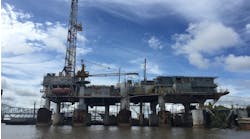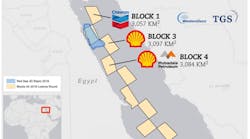Chevron has brought the much-anticipated Benchamas Field onstream. The field is located in Block B8/32 in the Gulf of Thailand and began initial production early last month at rates of 35 MMcf/d of gas and 2,200 b/d of oil. Production is being carried out from three platforms with 48 wells. Oil is transported to a floating storage and offloading facility for export while the gas is sold under contract to the Petroleum Authority of Thailand.
Production from the field is expected to increase to 75 MMcf/d of gas and 25,000 b/d of oil by next month. Chevron plans to increase production next year with the addition of several satellite production platforms.
Benchams is the second of three major fields in Block B8/32 to come onstream. The first was Tantawan, which came onstream in February of 1997, and the third being Maliwan, expected to begin production in late 2001. Chevron has estimated that the entire block holds as much as 3 tcf of gas and 350 million bbl of oil. The company expects total production from the block to reach 145 MMcf/d of gas and 30,000 b/d of oil by the end of the year.
Chevron acquired a majority interest in the block earlier this year with its acquisition of Rutherford Moran Oil. With the acquisition, Chevron's interest in the block raised to 51.66% and, subject to government approval, will become operator on October 1. Thaipo, a subsidiary of Pogo Producing is currently the operator and holds 46.34% and Palang Sophon holds the remaining 2%.
Progress on Australia-Timor's Bayu-Undan
The highly controversial and oft delayed project to develop the LNG reserves of the Bayu-Undan Field in ZOCA 91-12 and 91-13 in the East Timor Sea, has final begun to make progress. Recently, all the joint venture partners of the project agreed to and signed a unitization agreement and unit operating agreement. This included Phillips Petroleum, Santos, Inpex, Oryx/Kerr-McGee, Petroz, and British-Boreno. The agreement outlined procedures for effective dispute resolution with the joint venture partnership and has been submitted to the Joint Authority, the governing body over the Zone of Cooperation Area (ZOCA) between Australia and Indonesia, for approval.
This signing is seen as the first major step forward for the project. The project has been increasingly delayed for over 18 months due to disputes between member parties, namely Phillips and BHP. The two companies openly contested plans for the field's LNG plant, until BHP sold its interest in the project to Phillips and the company assumed the role of operator.
Project partners expect to submit the final development plan to the Joint Authority soon and anticipate the final go-ahead later this year. If this goes to plan, first LNG production could begin by late 2003 with initial production of 110,00 b/d of liquids.
Bayu-Undan is estimated to hold more than 300 million bbl of condensate and LPG.
Development will involve three production platforms and a floating storage and offloading vessel. Total project cost is expected to be in the range of $1.31 billion.
On another note, Australia is on the verge of signing a $15 billion deal to supply LNG to China. Reports have indicated Australia as the front-runner for the deal, ahead of Malaysia and several Middle Eastern countries. A six-company consortium called Australia LNG comprising BHP, BP Amoco, Chevron, MIMI, Shell, and Woodside, is bidding on the contract. The negotiation entails China purchasing three million tons of LNG per year based on a 20-year contract valued at up to $15.4 billion.
Chinese officials have attributed Australia's advantage to its proximity to China and political stability. Also noted was Australia's support for China in its dispute with Taiwan. If won, the contract would be Australia's biggest supply contract since a $1.5 billion contract with Japan for gas from the Northwest Shelf back in the 1980s.
Vamex signs on for disputed blocks
Vietnam American Exploration (Vamex) of the US has signed a 30-year production sharing contract with PetroVietnam for two blocks offshore Vietnam. The contract covers exploration and production of two blocks covering 6,874 sq km. The blocks also border a 2 Tcf gas field operated by BP Amoco. However, like a great deal of other concessions in the region, the blocks are under dispute. The blocks overlap waters claimed by Indonesia and are subject to overlapping boundary claims based on the 1982 Law of the Sea.
Friendly negotiations have been underway between Vietnam and Indonesia over the dispute and Vamex has said that it does not plan to begin exploration efforts until the matter is resolved. The dispute is expected to be resolved within the next few years. In the meantime, Vamex has said that it will concentrate efforts on attracting one or more international oil companies in the venture and conduct a seismic program.
WAPET begins deepwater program
West Australian Petroleum (WAPET) has begun a deepwater drilling program to hopefully extend the potential of the Gorgon gas field offshore Western Australia. The company is using the Marine 500 semisubmersible for a three-well program in up to 1,300 meters water depth, close to the deepest ever drilled offshore Australia.
The first well, Euryale, is in exploration permit WA-205-P, to the west of Gorgon. The second and third wells will be drilled in WA-267-P to the north of Gorgon. Following the program, the rig will go on a short-term contract for another operator, and then return to WAPET in the first quarter of next year for an additional four to five well program.
High hopes for New Zealand gas
Hopes are still high for New Zealand's possibility as an oil and gas province, despite the disappointment of Conoco's dry deepwater well. Orion New Zealand is expected soon to release the reserve figures for what is believed to be a significant gas discovery. The Kauhauroa gas discovery was drilled on the east coast of New Zealand's North Island and would mark the first commercial gas discovery outside the boundary of the west coast Taranaki region, thus establishing a new play. Partner in the project, Wastech Energy has said that it anticipates the reserves to be "hundreds of billions of cu ft of gas." If this is indeed the case, New Zealand may have established a new play and begin attracting major international interest in its petroleum sector.


